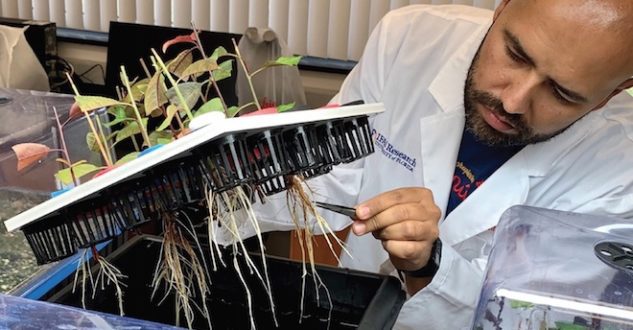
Feb 4, 2021Florida breeding seeks regionally-adapted peach rootstocks
University of Florida researchers are getting to the root of a problem faced by peach growers in the state.
Their problem: The tree roots themselves, or the lack thereof.
With only one major rootstock available for grafting to peach-bearing cultivars, disease issues are nearly unavoidable for Florida growers, who have about 2,000 acres planted with peach trees meant to supply fresh fruit sales March through May.
So, work goes on at the University of Florida Institute of Food and Agricultural Sciences (UF/IFAS) where fruit tree breeders and continue to look for something better.


In the current state of affairs, “we can only go up,” said José Chaparro, UF/IFAS horticultural sciences department associate professor of fruit tree breeding and genetics.
In the pits
Florida rootstocks have essentially been a monoculture since the 1980s, relying on Flordaguard, while Georgia has heavily used Guardian, Chaparro said. Most of the cultivated peach varieties are low-chill types, said Ph.D. candidate Ricardo Lesmes-Vesga, who works at the UF/IFAS Indian River Research and Education Center (IRREC) in Fort Pierce.
As a rootstock, Flordaguard has genetic limitations, having no genes from plum trees, and Florida orchardists battle with an army of root pathogens, including armillaria root rot also known as oak root rot, peach root knot nematode (Meloidogyne floridensis) and peach gummosis (Botryosphaeria dothidea), Chaparro said. Also, the rootstock doesn’t tolerate flooding well, and flooding is a reality in Florida’s Indian River area, a narrow strip of land on the eastern seaboard that’s one of the state’s two key regions for peach-growing. The other region is a central or “ridge” area near Lake Alfred.
The goal would be at least two peach rootstock varieties – one for each of the two Florida regions. Ideally, a rootstock for Florida’s ridge area would be a deep-rooted plant, well-equipped for drawing nutrients out of the sandy soils – Chaparro calls them ancient sand dunes – that drain so well. The Indian River area, on the other hand, has “an organic hard pan” that frequently fills with water, flooding orchards. Indian River trees are typically planted in raised beds that are two trees wide, with drainage ditches between the beds. The flooding in the Indian River area would lend itself to a rootstock with shallower root system.
“We want vigorous systems in both soil types,” Lesmes-Vesga said.


Genetic work
Lesmes-Vesga’s research work involves phenotyping peach root systems to identify root systems adapted to the two different soil regions. Chaparro, one of the scientists overseeing Lesmes-Vesga’s work, said research is looking at the root architecture of the various genetic variations.
“We are evaluating peach relatives such as almond (prunus dulcis) and gansu peach (p. kansuensis) and more distantly related species like bullace plum (p. umbellata), Chickasaw plum (p. angustifolia) and myrobolan plum (p. ceracifera),” Lesmes-Vesga said.
His work also includes looking at different fruit-bearing cultivars for scions.
Right now, “basically, most of the cultivated peach varieties in Florida are low-chill. The most popular subtropical varieties are the non-melting flesh ‘UFSun,’ ‘UFBest’ and the melting flesh cultivar ‘TropicBeauty,’” he said.
At IRREC, Lesmes-Vesga works at both the laboratory and greenhouse since he works with seedlings year-round. During the cool months, red lights simulate daylight to prevent the trees from going dormant. Cuttings from the nursery trees are rooted inside aeroponics systems and stimulated with rooting hormones.
“New rootstock and scion breeding selections are made every year and undergo tests to determine their commercial viability,” he said. “Rootstock testing requires a significant investment of time and effort to ensure that there are no major flaws in germplasm nearing release. We expect to release additional low chill peach scion cultivars in the near future and rootstocks at a later time.”
Implications elsewhere
Florida peach growing is much different than other regions because of the low-chill cultivars used, Chaparro said. The ridge area in central Florida is sub-tropical in climate, and the peach varieties grow best with a minimal number of chill hours – just 150-250. However, some of the other cultivars in the Indian River area are less low-chill, operating with about 50-150 chill hours.
“It is unlikely that a rootstock under Florida conditions will be adapted to high chill peach production areas, Lesmes-Vesga said. “However, moderate chill rootstocks with broad spectrum root knot nematode resistance should be useful in other moderate chill locations with acidic soils such as southern Georgia, Alabama, Mississippi and Texas. Some of our germplasm is currently under test in California.
“The stone fruit breeding program at the University of Florida headed by Dr. Jose X. Chaparro cooperates closely with the USDA-ARS stonefruit rootstock breeding program at Byron, Georgia and we test some of their advanced selections for nematode resistance on site. However, we are also breeding lower chill rootstocks for subtropical peach production in Florida.”
Importance of investment
The hours of careful research in the lab and greenhouse informs the peach breeding program.
New rootstocks and scions bred by Chaparro are hoped to increase Florida’s peach production range, improve the commercial trees’ performance and help Florida’s stone fruit growers stay profitable.
For Florida to get to its current stage required decades of investment. Chaparro is the state’s third peach tree breeder. After the state first launched its breeding program in 1952, it was 24 years until the first commercial-quality variety, Flordaprince, was released. The program has focused on non-melting flesh peaches with improved shipping quality.
While his research continues, Chaparro said he’s concerned that universities across the country have lost fruit tree breeders since the 1980s simply through attrition.
“We need more rootstock breeders,” Chaparro said. “The number of programs nationwide is significantly lower.”
— Stephen Kloosterman, associate editor; Photo at top: Ricardo Lesmes-Vesga, a Ph.D. candidate at UF, examines the root systems of peach plants grown by aeroponics in the laboratory. Photo: University of Florida














